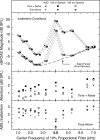Changes in otoacoustic emissions during selective auditory and visual attention
- PMID: 25994703
- PMCID: PMC4441704
- DOI: 10.1121/1.4919350
Changes in otoacoustic emissions during selective auditory and visual attention
Abstract
Previous studies have demonstrated that the otoacoustic emissions (OAEs) measured during behavioral tasks can have different magnitudes when subjects are attending selectively or not attending. The implication is that the cognitive and perceptual demands of a task can affect the first neural stage of auditory processing-the sensory receptors themselves. However, the directions of the reported attentional effects have been inconsistent, the magnitudes of the observed differences typically have been small, and comparisons across studies have been made difficult by significant procedural differences. In this study, a nonlinear version of the stimulus-frequency OAE (SFOAE), called the nSFOAE, was used to measure cochlear responses from human subjects while they simultaneously performed behavioral tasks requiring selective auditory attention (dichotic or diotic listening), selective visual attention, or relative inattention. Within subjects, the differences in nSFOAE magnitude between inattention and attention conditions were about 2-3 dB for both auditory and visual modalities, and the effect sizes for the differences typically were large for both nSFOAE magnitude and phase. These results reveal that the cochlear efferent reflex is differentially active during selective attention and inattention, for both auditory and visual tasks, although they do not reveal how attention is improved when efferent activity is greater.
Figures









Similar articles
-
Olivocochlear efferents: Their action, effects, measurement and uses, and the impact of the new conception of cochlear mechanical responses.Hear Res. 2018 May;362:38-47. doi: 10.1016/j.heares.2017.12.012. Epub 2017 Dec 21. Hear Res. 2018. PMID: 29291948 Free PMC article. Review.
-
Selective attention reduces physiological noise in the external ear canals of humans. I: auditory attention.Hear Res. 2014 Jun;312:143-59. doi: 10.1016/j.heares.2014.03.012. Epub 2014 Apr 13. Hear Res. 2014. PMID: 24732069 Free PMC article.
-
Examining replicability of an otoacoustic measure of cochlear function during selective attention.J Acoust Soc Am. 2018 Nov;144(5):2882. doi: 10.1121/1.5079311. J Acoust Soc Am. 2018. PMID: 30522315 Free PMC article.
-
Selective attention reduces physiological noise in the external ear canals of humans. II: visual attention.Hear Res. 2014 Jun;312:160-7. doi: 10.1016/j.heares.2014.03.013. Epub 2014 Apr 13. Hear Res. 2014. PMID: 24732070 Free PMC article.
-
Evidence against attentional state modulating scalp-recorded auditory brainstem steady-state responses.Brain Res. 2015 Nov 11;1626:146-64. doi: 10.1016/j.brainres.2015.06.038. Epub 2015 Jul 14. Brain Res. 2015. PMID: 26187756 Free PMC article. Review.
Cited by
-
Selective Attention to Visual Stimuli Using Auditory Distractors Is Altered in Alpha-9 Nicotinic Receptor Subunit Knock-Out Mice.J Neurosci. 2016 Jul 6;36(27):7198-209. doi: 10.1523/JNEUROSCI.4031-15.2016. J Neurosci. 2016. PMID: 27383594 Free PMC article.
-
Cochlear activity in silent cue-target intervals shows a theta-rhythmic pattern and is correlated to attentional alpha and theta modulations.BMC Biol. 2021 Mar 16;19(1):48. doi: 10.1186/s12915-021-00992-8. BMC Biol. 2021. PMID: 33726746 Free PMC article.
-
Heightened visual attention does not affect inner ear function as measured by otoacoustic emissions.PeerJ. 2017 Dec 21;5:e4199. doi: 10.7717/peerj.4199. eCollection 2017. PeerJ. 2017. PMID: 29302404 Free PMC article.
-
Evaluation of Contralateral Suppression of Otoacoustic Emissions in Bharatanatyam Dancers and Non-Dancers.J Int Adv Otol. 2019 Apr;15(1):118-120. doi: 10.5152/iao.2018.5645. J Int Adv Otol. 2019. PMID: 30541728 Free PMC article.
-
Olivocochlear efferents: Their action, effects, measurement and uses, and the impact of the new conception of cochlear mechanical responses.Hear Res. 2018 May;362:38-47. doi: 10.1016/j.heares.2017.12.012. Epub 2017 Dec 21. Hear Res. 2018. PMID: 29291948 Free PMC article. Review.
References
-
- Brown, M. C. (2011). “ Anatomy of olivocochlear neurons,” in Auditory and Vestibular Efferents, edited by Ryugo D. K., Fay R. R., and Popper A. N. ( Springer, New York: ), pp. 17–37.
Publication types
MeSH terms
Grants and funding
LinkOut - more resources
Full Text Sources
Other Literature Sources
Molecular Biology Databases
Miscellaneous

